
Reggio di Calabria, commonly and officially referred to as Reggio Calabria, or simply Reggio by its inhabitants, is the largest city in Calabria as well as the seat of the Regional Council of Calabria. It has an estimated population between 150,000 and 200,000 and is the twenty-first most populous city in Italy, after Modena, and the 100th most populated city in Europe. Reggio Calabria is located near the center of the Mediterranean and is known for its climate, ethnic and cultural diversity. It is the third economic centre of mainland Southern Italy. About 560,000 people live in the metropolitan area, recognised in 2015 by Italy as a metropolitan city.

Magna Graecia was the name given by the Romans to the Greek-speaking coastal areas of Southern Italy in the present-day Italian regions of Calabria, Apulia, Basilicata, Campania and Sicily; these regions were extensively populated by Greek settlers starting from the 8th century BC.
Locri is a town and comune (municipality) in the province of Reggio Calabria, Calabria, southern Italy. Its name derives from that of the ancient Greek region of Locris. Today it is an important administrative and cultural centre on the Ionian Coast and within its province.
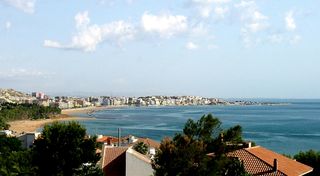
Crotone is a city and comune in Calabria, Italy.

Dionysius I or Dionysius the Elder was a Greek tyrant of Syracuse, Sicily. He conquered several cities in Sicily and southern Italy, opposed Carthage's influence in Sicily and made Syracuse the most powerful of the Western Greek colonies. He was regarded by the ancients as an example of the worst kind of despot: cruel, suspicious, and vindictive.

Sybaris was an important ancient Greek city situated on the coast of the Gulf of Taranto in modern Calabria, Italy.
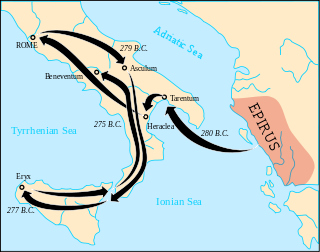
The Pyrrhic War was largely fought between the Roman Republic and Pyrrhus, the king of Epirus, who had been asked by the people of the Greek city of Tarentum in southern Italy to help them in their war against the Romans.
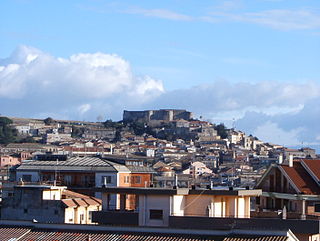
Vibo Valentia is a city and comune (municipality) in the Italian region of Calabria, near the Tyrrhenian Sea. It is the capital of the province of Vibo Valentia, and is an agricultural, commercial and tourist center. There are also several large manufacturing industries, including the tuna district of Maierato. Very important for the local economy is Vibo Marina's harbour.

The Messapians were an Iapygian tribe who inhabited Salento in classical antiquity. Two other Iapygian tribes, the Peucetians and the Daunians, inhabited central and northern Apulia respectively. All three tribes spoke the Messapian language, but had developed separate archaeological cultures by the seventh century BC. The Messapians lived in the eponymous region Messapia, which extended from Leuca in the southeast to Kailia and Egnatia in the northwest, covering most of the Salento peninsula. This region includes the Province of Lecce and parts of the provinces of Brindisi and Taranto today.

The Panionium was an Ionian sanctuary dedicated to Poseidon Helikonios and the meeting place of the Ionian League. It was on the peninsula of Mt. Mycale, about 100 kilometres (62 mi) south of Smyrna—now İzmir, in Turkey. Herodotus describes it as follows:
The Panionion is a sacred ground in Mykale, facing north; it was set apart for Poseidon of Helicon by the joint will of the Ionians. Mykale is a western promontory of the mainland opposite Samos; the Ionians used to assemble there from their cities and keep the festival to which they gave the name of Panionia.
Archon was a Pellaean, appointed satrap of Babylonia after the death of Alexander the Great in 323 BC. He is probably the same as the son of Cleinias mentioned in the Indian expedition of Alexander. He perished in 321 BC in a fight against Dokimos. An inscription in Delphi shows that Archon had taken part in both the Isthmian and Pythian Games of 333 to 332 BC, winning some horse-races.

Stilo is a town and comune in the province of Reggio Calabria, in the Calabria region of southern Italy. It is 151 kilometres (94 mi) from Reggio.
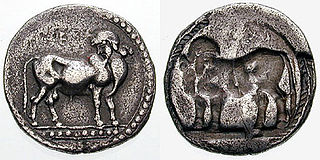
Laüs or Laus was an ancient city on the coast of the Tyrrhenian Sea. It was at the mouth of the Lao River, which formed the boundary between Lucania and Bruttium in ancient times and gave it its name.
Sybaris on the Traeis was an ancient city situated on the Traeis river, now known as the Trionto. It shares its name with the original city of Sybaris which was destroyed in 510 BC. Its former inhabitants built a new city, Thurii, not far from the site of Sybaris. This new colony was founded together with other Greek settlers in 446/445 BC. Soon a conflict arose between the two groups and most of the Sybarites were killed by the other Greek colonists of Thurii. The Sybarites who managed to flee then founded Sybaris on the Traeis a short time after 444 BC. The city was destroyed by the Bruttii not long after their emergence as an ethnic group in 356/355 BC.

The Vallata dello Stilaro is a valley in the Province of Reggio Calabria of Southern Italy. It takes its name from river that flow in the area, the Stilaro.

Cranon or Crannon (Κραννών) was a town and polis (city-state) of Pelasgiotis, in ancient Thessaly, situated southwest of Larissa, and at the distance of 100 stadia from Gyrton, according to Strabo. Spelling differs among the sources: Κράννων and ῂ Κράννωνοϛ; Κραννών, Κράννουν, and Κράννουϛ. To the west it bounded with the territory of Atrax and to the east with that of Scotussa. To the south the ridges of the Revenia separated it from the valley of the river Enipeus.

The Museo Nazionale della Magna Grecia, Museo Archeologico Nazionale di Reggio Calabria or Palazzo Piacentini is a museum in Reggio Calabria, southern Italy, housing an archaeological collection from sites in Magna Graecia.

Terina was an ancient city located on the Piano di Tirena hill in Sant'Eufemia Vetere about 20 km (12 mi) from Lamezia Terme in Calabria. The site of the city was allegedly found in 1922 by the archaeologist Paolo Orsi near the modern village of Sant'Eufemia Vetere. A systematic archaeological investigation was made from 1997 and coins, inscriptions and other artefacts retrieved from the site can be seen in the Museo Archeologico Lametino in Lamezia Terme.
Temesa, later called Tempsa, was an ancient city in Italy, on the shore of the Tyrrhenian Sea. It was situated close to Terina, but its precise location has not yet been found. It is thought to have been located near the Savuto river to the north of the Gulf of Sant'Euphemia. More recently Campora San Giovanni, a town near the mouth of the Savuto, has been considered as a more precise location. The archeologist Gioacchino Francesco La Torre excavated a temple outside the town in the early 2000s, which was within the territory of Temesa.
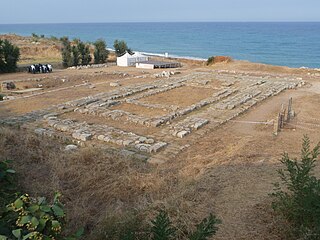
Caulonia or Caulon was an ancient city on the shore of the Ionian Sea near Monasterace, Italy.
















